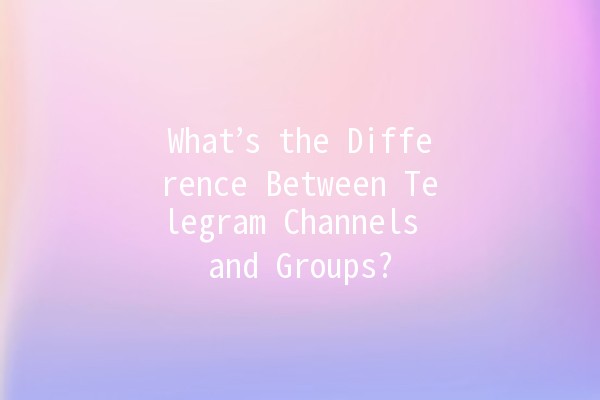In the world of instant messaging, Telegram has established itself as a powerful tool for communication, appealing to both casual users and professional networks. Two of the most prominent features in Telegram are channels and groups. While they may seemingly serve similar purposes of spreading information and connecting people, they have distinct differences that cater to varying needs. This article examines these differences in detail, providing practical tips to enhance your productivity while utilizing Telegram effectively.
Understanding Telegram Channels ?
What Is a Telegram Channel?
A Telegram channel is a platform where one or more administrators can post messages that all subscribers can see. Unlike groups where every member can contribute to the conversation, a channel allows for a more broadcaststyle communication. Channels can have an unlimited number of subscribers, and only the channel admin can send messages. Telegram官网
Key Features of Channels

Use Cases for Channels
News Updates: Ideal for news organizations to push updates quickly.
Marketing: Brands use channels to inform subscribers about products, updates, and promotions.
Understanding Telegram Groups ?
What Is a Telegram Group?
Telegram groups are a forum where multiple participants can share messages, images, files, and engage in conversations. Unlike channels, groups facilitate twoway communication—everyone in the group can contribute.
Key Features of Groups
Use Cases for Groups
Community Engagement: Great for community support groups or fan clubs.
Team Collaboration: Ideal for project teams needing realtime feedback and discussion.
Key Differences Between Channels and Groups
| Feature | Channels | Groups |
||||
| Communication Type| Oneway (from admin to subscribers) | Twoway (interactive) |
| Member Participation | Only admins can post | All members can post |
| Size Limit | Unlimited | Up to 200,000 members |
| Content Control | Admins control content | Members contribute equally |
| Purpose | Broadcasting information | Discussions and collaborations |
Enhancing Productivity with Telegram ?
Utilizing Telegram effectively can improve your productivity significantly, whether it’s for personal use, team collaboration, or community management. Here are five tips on how to leverage its features.
Explanation: Create a channel to disseminate crucial information to all members without the noise of discussions.
Example: If you're running an organization, set up a channel for announcements where you post meeting notices, project updates, or emergency information. This ensures everyone receives essential updates promptly.
Explanation: For projects where input and discussion are necessary, groups serve best.
Example: Set up a team project group where all members can share updates, ask questions, and provide feedback. Utilize this space for brainstorming sessions and regular checkins.
Explanation: Use the scheduled messages feature available in both groups and channels to post during peak engagement times.
Example: If your audience is most active during evenings, schedule posts during that time to increase visibility and engagement. This is particularly useful for channels aimed at marketing purposes.
Explanation: Use the poll feature in groups to gather feedback or make decisions collaboratively.
Example: When planning an event, create a poll to gauge interest in dates or activities. This participative approach encourages engagement and ensures that decisions are made based on the group’s preferences.
Explanation: For the smooth functioning of groups, outline rules and guidelines.
Example: Create a pinned message in your group detailing acceptable behavior, posting etiquette, and how to use group tools. This ensures that interactions remain constructive and focused.
Frequently Asked Questions
Answer: No, a channel is designed for oneway communication. Only admins can post messages in a channel, while all subscribers will receive updates without the ability to respond. For discussions, members should turn to a group where everyone can contribute and share their thoughts.
Answer: You can search for channels and groups by using the Telegram search bar. Simply enter keywords related to the topic you are interested in, and Telegram will display relevant channels and groups. Additionally, you can explore public groups and channels through various online databases and directories.
Answer: Privacy can be a concern as channels and groups can be public or private. In public channels, anyone can find and join, while private channels require an invite. It’s essential to consider what information you wish to share, especially in public channels. Always familiarize yourself with the privacy settings available to ensure your content is protected as needed.
Answer: Unfortunately, you cannot directly convert a group into a channel or a channel into a group. However, you can create a new channel or group and manually transfer your subscribers or members if necessary. This might involve sharing the new link in the existing platform and encouraging members to join.
Answer: There are several strategies to promote your Telegram channel or group:
Share the link on your social media platforms.
Use relevant hashtags to increase discoverability.
Collaborate with influencers or other channels to reach wider audiences.
Offer incentives, such as exclusive content, to encourage people to join.
Answer: Managing large groups requires clear roles and rules. You can appoint additional admins to help with moderation and establish specific guidelines to keep interactions respectful and ontopic. Using pinned messages can help guide users on the appropriate conduct and behavior expected in the group.
By understanding the differences between Telegram channels and groups, and how to leverage their functionalities, you can maximize your communication strategy. Whether you're looking to spread information or foster collaborative discussions, mastering these tools will undoubtedly enhance your productivity and engagement on the platform! Happy messaging!